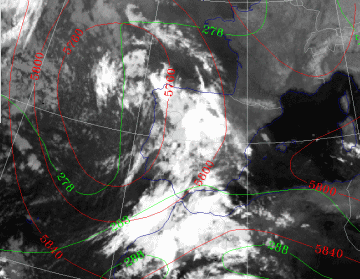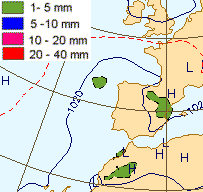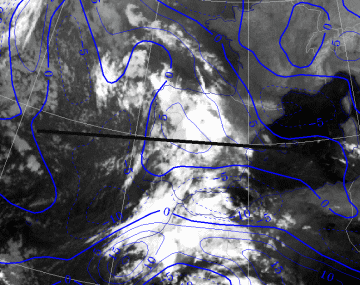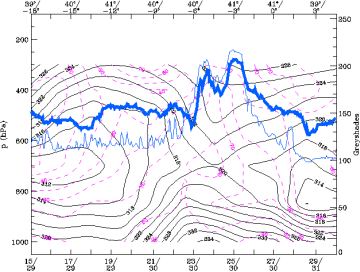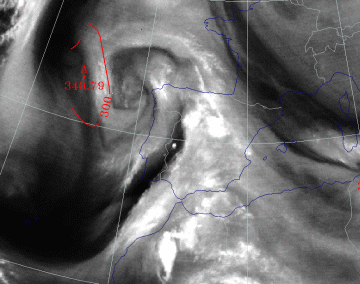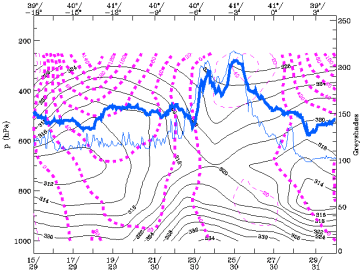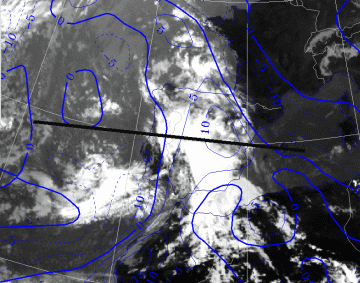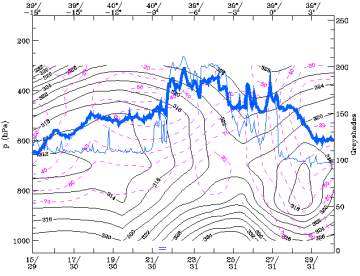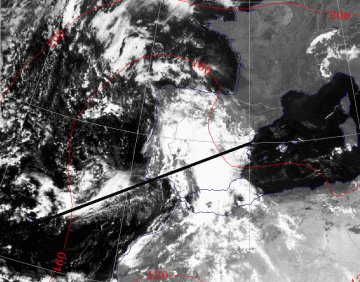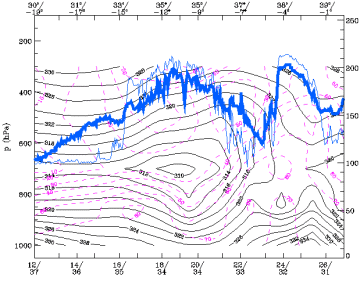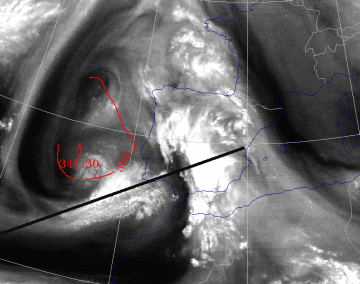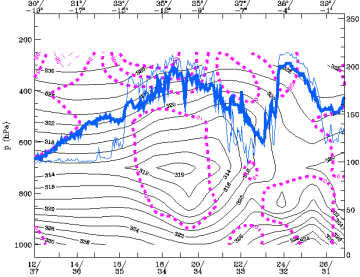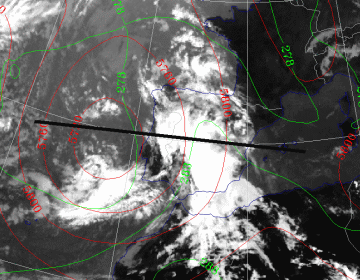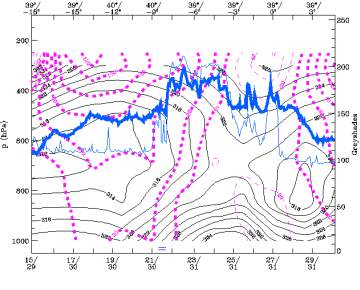The Tear-off Stage
|
24 September 1997/23.00 UTC - Meteosat VIS image; green: equivalent thickness 500/850 hPa, red: height contours 500 hPa
|
25 September 1997/00.00 UTC - Surface chart; accumulated precipitation 12.00 - 00.00 UTC
|
An extended area of high pressure is stretching out from the Azores towards the North Sea. The Iberian Peninsula is under the influence of a
low pressure area. The height of 500hPa is showing a closed circulation around a minimum of 576 gpdam, indicating an Upper Level Low in it's
tear-off stage which is characterised by the development of an inverted omega shape (Compare
Conceptual Models: Upper Level Low - Meteorological physical background
). The thickness trough is still west of the 500 hPa minimum which is a signal for further development of the Upper Level Low.
The cloud band over Spain no longer has any connection with the original front over the Bay of Biscay and Ireland.
26 September 1997/00.00 UTC
Analysis of the system
|
26 September 1997/00.00 UTC - Meteosat IR image; blue: thermal front parameter (TFP) 500/850 hPa; position of vertical cross section
indicated
|
26 September 1997/00.00 UTC - Vertical cross section; black: isentropes (ThetaE), magenta: relative humidity, blue thin: IR pixel
values, blue thick: WV pixel values
|
A maximum of the TFP accompanies the frontal cloud band, which is extending from N. Morocco to NW Spain.
This is a combination of the front which came from the west at 25/9 and the baroclinic zone over Morocco that day. The TFP from the model now
fits quite well with the cloud pattern. The more eastern front over NE Spain on the 25 September has dissolved almost completely.
In the cross section the front has the characteristics of an occlusion. The ThetaE pattern also shows a strong unstable layer below 700 hPa in
that area.
|
26 September 1997/00.00 UTC - Meteosat IR image; red: height of PV=2 units
|
26 September 1997/00.00 UTC - Vertical cross section; black: isentropes (ThetaE), magenta: relative vorticity, blue thin: IR pixel
values, blue thick: WV pixel values
|
The spiral in the WV image off the NE coast of Portugal, indicates the centre of the ULL. In the cross section a maximum in vorticity is calculated at that position. The maximum of the geopotential height of the PV=2 units is more to the west indicating dry descending air.
26 September 1997/12.00 UTC
Analysis of the system
|
26 September 1997/12.00 UTC - Meteosat IR image; blue: thermal front parameter (TFP) 500/850 hPa; position of vertical cross section
indicated
|
26 September 1997/12.00 UTC - Vertical cross section; black: isentropes (ThetaE), blue: relative humidity, blue thin: IR pixel
values, blue thick: WV pixel values
|
The TFP from the model doesn't fit well with the image, when compared with the humidity parameter and the various grey shades of the IR; the maximum of relative humidity is calculated to be more to the east.
|
26 September 1997/12.00 UTC - Meteosat IR image; red: height 1000 hPa; position of vertical cross section indicated
|
26 September 1997/12.00 UTC - Vertical cross section; black: isentropes (ThetaE), magenta: relative humidity, blue thin: IR pixel
values, blue thick: WV pixel values
|
South of the centre of the ULL, a cloud shield has rapidly developed. This shield is very distinct in IR and WV, but less clear in VIS. The
relative humidity parameter in the cross section shows a maximum at about 300hPa, fitting quite well with the images. At lower levels much less
humidity is present indicating an upper air feature.
This cloud shield is the result of upper level convergence which is often observed at the western and southern part of an ULL in its tear-off
stage.
|
26 September 1997/12.00 UTC - Meteosat IR image; red: height of PV=2 units; position of vertical cross section indicated
|
26 September 1997/12.00 UTC - Vertical cross section; black: isentropes (ThetaE), magenta thick: vorticity advection - PVA, magenta
thin: vorticity advection - NVA, blue thin: IR pixel values, blue thick: WV pixel values
|
The idea of an upper air feature is strengthened by the PVA parameter in the Cross section; a PVA maximum is found only very high in the
troposphere while at 500hPa the PVA is about zero.
In the WV image two vortexes can be detected. Both are in an area of low tropopauses as can be seen by the relative low height of the PV = 2 in
that area, with a minimum of 347 hPa near the centre of the southern vortex. The two rotation centres form a "mushroom" configuration
which is known in literature as the start of a cut-off process in the development of an ULL.
|
26 September 1997/12.00 UTC - Meteosat IR image; green: equivalent thickness 500/850 hPa, red: height contours 500 hPa
|
26 September 1997/12.00 UTC - Vertical cross section; black: isentropes (ThetaE), magenta: relative vorticity, blue thin: IR pixel
values, blue thick: WV pixel values
|
The tear-off stage becomes more pronounced, as can be seen in the contours, which are showing values of less than 572 gpdam in the centre of
the ULL, indicating stronger cyclonic rotation.
Cold advection prevails over the Atlantic Ocean (West of Portugal), whilst warm advection is still going on above the whole Iberian Peninsula.
This can be seen in the contours at 500 hPa, which are perpendicular to the lines of equivalent thickness, meaning the ULL is still moving and
developing.
The cross section shows strong vorticity in the centre of the ULL especially at higher levels (300hPa).
